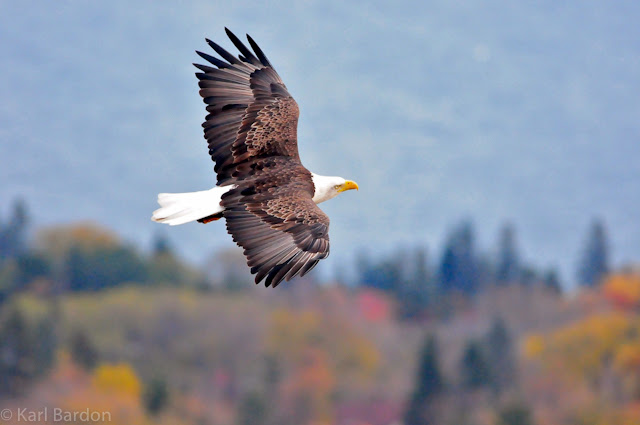Raptors
Most of the week was heavily overcast with fog, mist and
drizzle, giving us some very low counts for raptors and non-raptors, but the
good news was that once this weather cleared out with west winds on November 2nd,
we got a great push of birds including 141 Bald Eagles, 21 Golden Eagles, 10
Northern Goshawks, and 155 Rough-legged Hawks. This count of Rough-legs is the
third highest for Hawk Ridge, and the best flight since 1994 when 176 were seen
on November 29th (the record count is 204 birds seen at the Ridge on November 10th,
1963). With most of November yet to come, when the majority of Rough-legs often
move through, I am hoping for some more great Rough-leg days. In contrast to
last year when very few juvenile Rough-legs were seen, this year there are good
numbers of both adults and juveniles. Although it seems likely that most
Red-tails and Northern Goshawks have moved through, no doubt there are still good
numbers of Bald and Golden Eagles yet to come. If we get a major cold front in
the next few weeks, there will likely be hundreds of Balds and dozens of
Goldens riding the Ridge.
Non-raptors
The same weather which held back raptor migration for most
of the last week also did the same for non-raptors, with a great flight
commencing on November 2nd, when 4881 non-raptors flew over, most of
which were American Robins, but a good diversity of other species showed up as
well, such as Horned Larks, American Pipits, Snow Buntings, Red-winged
Blackbirds, Rusty Blackbirds, Eastern Bluebirds, and a few Pine Grosbeaks and
Red Crossbills. Most non-raptor migration is usually done by November, so this
flight was somewhat unusual. With continued relatively mild conditions (and
still some fall color left in the trees!), it seems possible that we will see
more of these species.
A few Boreal Chickadees have shown up, including two on
November 2nd, so perhaps this is the beginning of an irruption for
this species. In contrast, it is quite clear by now that this is one of the
worst finch years I have ever experienced. Whenever there have been good
irruptions of northern finches during these non-raptor counts, they have peaked
in late October, so it seems doubtful that any large numbers are still on their
way. In the last five years, the overall number of finches counted has varied
from 13,000-50,000, and this year the total is only at 11,819, most of which
were American Goldfinches. A few of the northern finches can be expected in
their usual range within the boreal forest of course, but I doubt that very many of them
will make it further south this winter. Nevertheless, a local bumper mountain
ash crop is already attracting robins, bluebirds and waxwings (including
Bohemians), so perhaps it will be a good season for berry eaters.
This blog was made possible by generous assistance from Cory
Ritter, Andrew Longtin and Joe Beck: we may not have built the Eiffel Tower or
the Lift-bridge, but we certainly have counted a lot of birds together! Thanks
guys!
Karl Bardon
Count Director
Hawk Ridge Bird Observatory
 |
| Adult Bald Eagle flying below Hawk Ridge with fall color and Lake Superior in the background |

.JPG)







